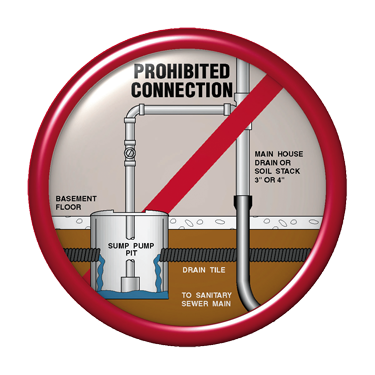“I&I” is a short acronym for a huge problem most sewer communities face, Infiltration and Inflow.
Inflow occurs when rainwater is misdirected into the sanitary sewer system instead of storm sewers. Examples are: roof leaders, yard and area drains, manhole covers, sump pumps, and cross connections from storm drains. The remedy for inflow is to remove improper connections to the sanitary sewer system.
Infiltration occurs when ground water seeps into the sanitary sewer system through cracks or leaks in sewer pipes. The cracks or leaks may be caused by age related deterioration, loose joints, damage or root infiltration. The remedy for infiltration is repairing or replacing the leaking infrastructure. Ignored I&I results in excessive flows in the sewers and into the wastewater treatment plant. This becomes a very costly problem for all of us.
I&I affects the quantity of wastewater that needs to be treated, the capacity of Dover Township’s sewer pipes, wastewater treatment plant and ultimately, the rate businesses and residents pay to operate and maintain them. The worst impact of I&I is the possibility that the excess sewage flows out of the sewer pipe and into our environment. I&I takes up valuable capacity in the WWTP and may limit future sewer connections. I&I adversely affects the nutrient loadings for the plant discharge. If ignored, I&I could cost this community millions of dollars.
The municipality is responsible for maintaining the sewers on streets and public right of ways. Dover Township has an on-going program to reduce the quantity of I&I in the sanitary sewer system. A pothole in the street is easy for all of us to see and know that repairs are needed. Since the sewers are underground, special equipment and techniques are used to locate problems. Specialized robotic video cameras are lowered into manholes and travel down the sewer pipes. Flow meters, smoke testing, conductivity sampling are also used in our program to locate problems in sewers. Several sections of the sewers have been replaced. After problems are located, repair and rehabilitation contracts are bid and awarded. Continued investigations and repairs of sewers will persist for many years.
Homeowners are responsible for maintaining their building sewers on their private property. You, as a homeowner, can reduce I&I from your property.
- Check that gutters and outside drains are not connected to the sewer system. Disconnect any drains that are found to be connected.
- Avoid planting trees and shrubs over building sewers. The roots can damage the structure of the sewer pipe and cause leaks.
- Make sure that the caps are on your cleanouts. Lawn mowers have a tendency to break the plastic caps. Replacement lids are available at your local hardware store.
- Ensure that basement drains are not connected to the sanitary sewer and install a sump pump to the stormwater drainage system instead.
- Replace any known broken, leaky or problem sections of sewer pipe that are located on your property.
Sump Pumps into the Sanitary Sewer Cause Big Problems!
Besides the fact that connecting sump pumps to the sanitary sewer is illegal, it causes big problems! Sump pumps are designed to pump groundwater and rainwater. Sanitary sewer pipes are designed to carry sewage, not groundwater and rain water.
Usually, the sanitary sewer pipe in the street is only 8 inches in diameter, and often the pipe slope is not very steep. Many 8 inch sewer pipes are installed with a slope of 0.4%. This means that for every 100 feet of pipe, the pipe goes downhill less than 5 inches. This low slope condition is very common in Pennsylvania’s sewer collection systems. As you can imagine, there is only so much sewage water that can flow through this pipe
For this type of sewer pipe, about 300 gallons of water can flow through it in a minute. If more sewage than this tries to get through the pipe in the street, the sewage will surcharge, that is start filling up the sewer lateral pipes that run to the sewer main from houses. When even more sewage or extra water is sent to the sewer pipe, it will surcharge even farther, eventually pushing back into someone’s basement. The sewage might come out of a neighbor’s basement toilet or washing machine drain for example.
If hooked up to a house’s sewer lateral, a half-horsepower sump pump will pump about 60 gallons to the sewer each minute. That means that if 5 pumps are connected to the sewer, it will be full. Normal sewage flows often fill the sewer main more than half-way already. So if two or three neighbors in a block illegally connect their sump pumps to their sewer lateral, the flow that is trying to get through the sewer main will be more than its capacity of 300 gallons per minute. The sewage in the pipe is going to start backing up!
It is critical that sump pumps discharge to the yard or storm sewer, not to the sanitary sewer. It is illegal to connect your sump pump into your sanitary lateral, and it can cause serious problems!
More Sanitary Sewer Information





